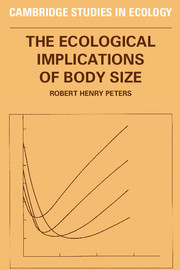Book contents
- Frontmatter
- Contents
- Preface
- 1 A philosophical introduction
- 2 A mathematical primer: Logarithms, power curves, and correlations
- 3 Metabolism
- 4 Physiological correlates of size
- 5 Temperature and metabolic rate
- 6 Locomotion
- 7 Ingestion
- 8 Production: Growth and reproduction
- 9 Mass flow
- 10 Animal abundance
- 11 Other allometric relations
- 12 Allometric simulation models
- 13 Explanations
- 14 Prospectus
- Appendixes
- References
- Index
5 - Temperature and metabolic rate
Published online by Cambridge University Press: 05 August 2012
- Frontmatter
- Contents
- Preface
- 1 A philosophical introduction
- 2 A mathematical primer: Logarithms, power curves, and correlations
- 3 Metabolism
- 4 Physiological correlates of size
- 5 Temperature and metabolic rate
- 6 Locomotion
- 7 Ingestion
- 8 Production: Growth and reproduction
- 9 Mass flow
- 10 Animal abundance
- 11 Other allometric relations
- 12 Allometric simulation models
- 13 Explanations
- 14 Prospectus
- Appendixes
- References
- Index
Summary
For most animals, body size is that universal characteristic that is most easily measured. As a result, many researchers include estimates of size in descriptions of their experimental animal, and empirical theories can be built from published data. Other variables, for example, protein content or metabolic rate, may be equally universal and, perhaps, even better predictors. However, because their determination is more difficult, they are far less frequently reported. Body size is also attractive because, as a continuous variable, it may be more easily treated mathematically and the power curve's repeated success makes the researcher's choice of statistical models clear. In part, body size is a good independent variable, because it is practical and convenient.
Only body temperature is as practical and convenient an independent variable as body size. Every organism has some body temperature, and, as a rule, this is easily measured. Long experience has shown that body temperature influences physiological rates, and temperature is, therefore, reported frequently. Like body mass, temperature is a continuous variable and is, therefore, amenable to regression analysis. Although no one mathematical function dominates the description of thermal response, the choice of statistical models is small (Bottrell 1975; McLaren 1963), and so statistical effort is reduced. Unlike body mass, there is a strong physicochemical rationale for the effect of temperature on chemical and biochemical rates.
- Type
- Chapter
- Information
- The Ecological Implications of Body Size , pp. 54 - 78Publisher: Cambridge University PressPrint publication year: 1983

